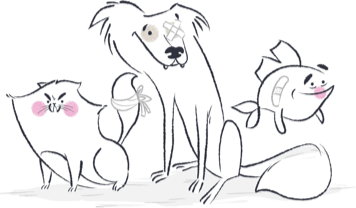ou just might be. That’s one of the surprising things that Nick Hill and his team at Sure Petcare discovered when they were developing Animo, their new activity and behavioural tracker for dogs. Surely it’s the other way around, I suggested to Nick when I talked to him recently. Dogs interrupt our sleep! But taking a look at the data shows the impact that pet parents’ sleep patterns have on their pets, who need a good night’s sleep just like we do.
I learned about Sure Petcare at the Cat Friendly awards (yes, they are a thing, and yes, it’s a really fun time!). At CatDogFish, we believe in businesses that are truly dedicated to making the lives of pets and pet owners better. It’s with this in mind that I set out to learn more about Nick and the company he’s built.
Nick is unlike anyone else I’ve ever met in that he is a physicist by training and a pet product developer by trade. He started Sure Petcare after receiving his doctorate in physics, because he wanted to find a way to stop neighbourhood cats from inviting themselves in through his cat Flipper’s cat flap. After a lot of trial, error, and personal investment, Nick built a the first cat flap in the UK that connected to a microchip. Connecting to Flipper’s microchip meant that the flap only worked for Flipper, and the neighbourhood cats were effectively shut out. Thus began Nick’s mission to build a connected ecosystem for pets.
But back to Animo, and pet activity monitors in general. Isn’t it a hugely crowded market already? And a somewhat confusing one for the pet owner to navigate? I asked Nick. What tech is best? What should pet parents look for?
Nick pointed out that an important distinction to make is between location trackers and activity / behaviour monitors. Anything that uses GPS is a location tracker and is brilliant for ensuring peace of mind if Fido goes walkabout. There are drawbacks to using GPS however, including a short battery life (most say they offer 2 – 5 days’ battery life, but a lot of times this is shorter in practice) and the need to use a separate SIM.
Behaviour and activity monitors, on the other hand, offer a different view into Fido’s health, and a much longer battery life (Animo’s battery lasts for 6 months, according to Nick).
Think of it as the ‘quantified self’ movement for dogs, whereby the more data you collect, the more you can learn about your dog’s health.
So what gets tracked? Animo records calorie burn (which I would find quite useful for my oh-so-lazy cats), walking, sleep quality (who knew?), barking, scratching and shaking. These last three are displayed after the dog has worn the collar for 14 days and the data has been collected.
So far, so data rich. As with all data, it’s only useful if you know what to do with it. With that in mind, I asked Dr. Chris Tufnell, my co-host on the CatDogFish Cast and an accomplished veterinarian, why having this data will make us better pet parents. According to Chris, the data builds up a picture of our dogs’ normal activity so it’s easier to identify any changes which might indicate an underlying problem.
For example, if the dog’s activity has reduced, it could mean the onset of arthritis, or increased activity like scratching could indicate an allergy or a bite. The data might also show increased anxiety, restlessness and whether the dog is drinking more water than normal, which could indicate dehydration or something more sinister. By noticing any aberrations and sharing with your vet, you stand a much better chance of catching any problems earlier and treating them more effectively.
Connected pet care, when done well, is actually a really good application of the Internet of Things.
Nick Hill, CEO & Founder, Sure Petcare
Nick’s vision for the future, which he’s well on his way to building, is the creation of a truly connected pet care ecosystem. “Connected pet care, when done well, is actually a really good application of the Internet of Things” he says. “It’s not just a gadget, it can help you deliver better quality pet care and have better engagement with your pets.” Nick is quick to point out, however, that it’s not about creating gadgets for the sake of it, but rather it’s all about connectivity.
In fact, Nick explains that activity monitoring hardware is straightforward and a bit commoditized, so the differentiation is going to come from the software. Realising a truly connected ecosystem means incorporating all kinds of data sets from various sources, where the differentiation is going to come is not in the hardware but the software that accompanies it.
But what about the cats? I would love to be able better understand the behaviours and activity (or lack thereof) of my babies Charlie and Henry. Nick explains that he isn’t a fan of anything that has to be attached to a cat via a collar, as these are inherently more dangerous and error-prone than they are on dogs. So until they can tie everything into the microchip, as they currently can with the cat flaps, we will just have to wait.




